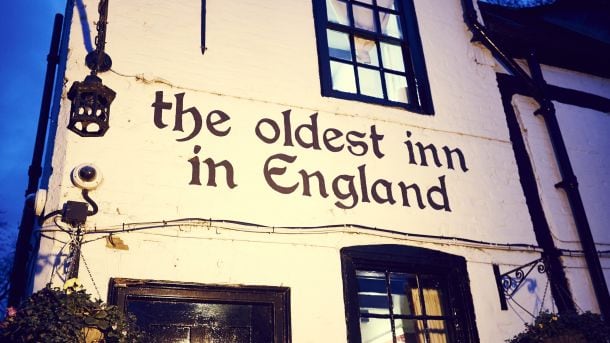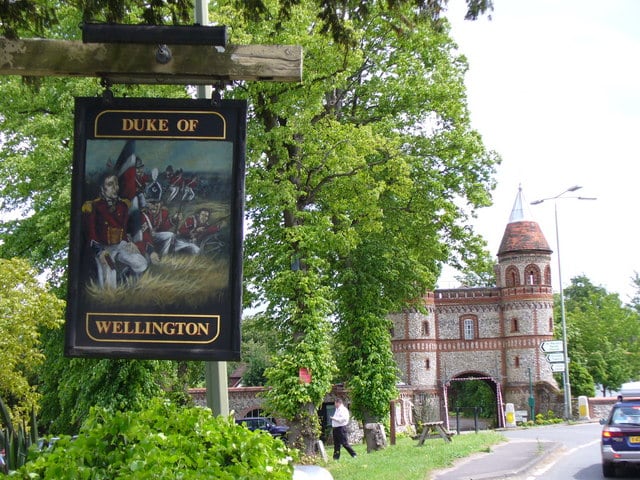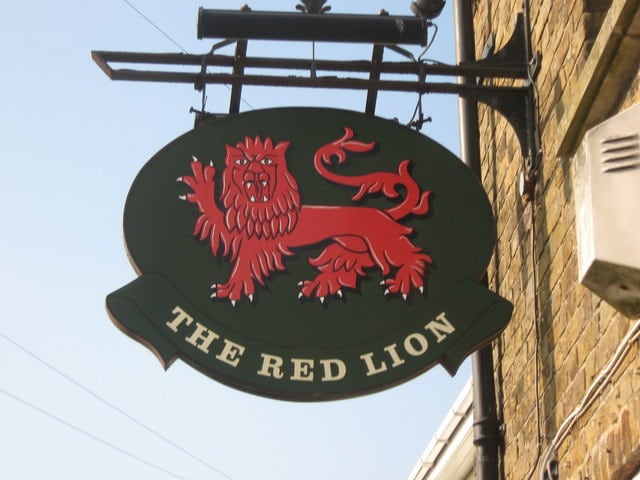Like many of the best things in civilised society, the iconic pub sign can be traced back to the Roman Invasion of Britain in AD 43. Aside from denoting a premises that delivers alcohol’s comforting embrace, the pub sign has acted as a secret UK history book over the course of two millennia.
Here are 21 reasons why…
1. The first pub sign was not a sign at all, but rather a wreath of vine leaves. As vines were not native to the UK, the adaptable Romans used bushes, evergreens or other foliage instead. Hence pubs called The Bush, The Yew Tree, The Bunch of Grapes and The Hollybush.
2. In an age when illiteracy was rife, these symbols were a necessary shorthand to help people recognise an inn/hostelry/public house. Signs, therefore, came before the name.
3. Nottingham’s Ye Olde Trip to Jerusalem is one of many that purports to be England’s oldest pub. It claims to date back to 1189, the year Richard the Lionheart acceded to the throne and the date the Third Crusades began. The Crusades gave rise to many pub signs eg. the Saracen’s Head, the Lamb and Flag.

4. In 1393, Richard II passed a law that meant pubs and inns had to display a sign so they were recognisable to the official Ale Taster. Richard’s emblem was the White Hart, which is why there are so many White Harts.
5. Before the Reformation many pub signs had religious connotations. Travelling pilgrims usually stayed in monasteries. When the monasteries were full enterprising locals set up private accommodation and adopted religious signs and symbols as a pictorial guide. Over time these hostels evolved into inns/pubs.
6. Pub signs developed over time. Often they would reflect changes in society. When King Henry VIII broke away from Rome many pubs changed names from The Pope’s Head to The King’s Head.
7. Signs have always had a close association with royalty. King Henry VIII’s favourite leisure pursuits found representation in The Greyhound, The Dog & Duck, The Bird in Hand and The Fox & Hound.
8. Public opinion has always been important in shaping pub signs/names. After the death of Oliver Cromwell and the restoration of the monarchy, The Crown saw a surge in popularity. As did The Royal Oak — after the tree in which the future Charles II hid in 1651 when escaping from Cromwell’s men.
9. Signs were often literal representations of other activities that took place on the premises. Take a bow, Ye Olde Fighting Cocks. Those with bears or bulls on the signs suggested bear and bull baiting.
10. Acting as an early forerunner to Heat magazine, pub signs were a barometer of celebrity culture. When they were at the peak of their popularity, national heroes such as Sir Francis Drake, Admiral Nelson and the Duke of Wellington all adorned pub signs up and down the country.

11. The expansion of coaching inns in the 18th century was reflected in the popularity of names such as The Coach & Horses and The Horse & Groom.
12. As consumerism expanded in the late 17th and early 18th century, people’s spending habits were dictated by taste and choice as much as necessity. Public houses had to stand out — signs denoted a point of difference in a pub’s standing and identity.
13. Signs became bigger, better and bolder. One-upmanship was common. Some, such as Ye Olde Starre Inn in York (it’s still there), had signs that spanned the road. In 1718 an elaborate sign in London’s Fleet Street was so heavy it pulled down the front of a building killing two people.
14. Ever wondered why there are so many pubs called the Marquis of Granby? Wonder no more. Granby was a successful Lieutenant-General in the British Army. He was also a benevolent man. In a time before army pensions he set up old soldiers from his regiment with pubs.
15. What about the Red Lion, supposedly Britain’s most popular pub name? That is widely attributed to James I. James was already the King of Scotland, and it’s thought public houses adopted the popular symbol of Scotland as a pub sign after his ascension to the English throne.

16. The Industrial Revolution brought with it signs displaying links to canals — Waterway and Navigation — and trains. The popularity of The Railway Tavern and The Station/Station Arms remains to this day.
17. Professions and trades also became popular signs/names — The Bricklayers/Blacksmiths/Carpenters Arms being examples. Pubs became unofficial employment exchanges.
18. With the coming of the railways in the 19th Century, London’s Camden Town became a lawless land come closing time. To counteract the English, Welsh, Irish and Scottish railway workers fighting each other, four pubs — each with a Castle suffix — were built. Hence the Windsor Castle (England), Caernarvon Castle (Wales), Dublin Castle (Ireland) and the (supposedly) deliberately misspelt Edinboro Castle (Scotland). The last two endure today.
19. In 1936 the first (and last) Inn Signs Exhibition was held in London. It attracted 18,000 visitors.
20. Wetherspoon's has a number of pubs that operate under the name The Moon Under Water. This name is taken from an essay George Orwell wrote explaining the qualities of his perfect pub.
21. An indicator that names continue to adapt is The Three Kings in London’s Clerkenwell. Today’s sign is adorned with pictures of Elvis, Henry VIII and King Kong. The pub dates from 1791 — some time before the emergence of Elvis’s gyrating hips and the scary gorilla. In Bristol, The Victoria in St Werburghs changed its original Queen Victoria sign to one depicting Posh Spice, Victoria Beckham, in 2002. When her star waned it was altered to Vicky Pollard of Little Britain fame. Recently refurbished, it has reverted to its original regal representation.
This article first appeared on the BT Sport for Business website
